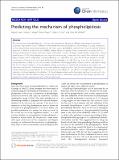Files in this item
Predicting the mechanism of phospholipidosis
Item metadata
| dc.contributor.author | Lowe, Robert | |
| dc.contributor.author | Mussa, Hamse Y. | |
| dc.contributor.author | Nigsch, Florian | |
| dc.contributor.author | Glen, Robert C. | |
| dc.contributor.author | Mitchell, John B. O. | |
| dc.date.accessioned | 2012-03-26T23:53:05Z | |
| dc.date.available | 2012-03-26T23:53:05Z | |
| dc.date.issued | 2012-01-26 | |
| dc.identifier | 18276128 | |
| dc.identifier | 945a51d2-83df-4473-a44d-7b108f9dc3b0 | |
| dc.identifier | 000300892200001 | |
| dc.identifier | 84862651254 | |
| dc.identifier.citation | Lowe , R , Mussa , H Y , Nigsch , F , Glen , R C & Mitchell , J B O 2012 , ' Predicting the mechanism of phospholipidosis ' , Journal of Cheminformatics , vol. 4 , 2 . https://doi.org/10.1186/1758-2946-4-2 | en |
| dc.identifier.issn | 1758-2946 | |
| dc.identifier.other | ORCID: /0000-0002-0379-6097/work/34033401 | |
| dc.identifier.uri | https://hdl.handle.net/10023/2463 | |
| dc.description.abstract | The mechanism of phospholipidosis is still not well understood. Numerous different mechanisms have been proposed, varying from direct inhibition of the breakdown of phospholipids to the binding of a drug compound to the phospholipid, preventing breakdown. We have used a probabilistic method, the Parzen-Rosenblatt Window approach, to build a model from the ChEMBL dataset which can predict from a compound's structure both its primary pharmaceutical target and other targets with which it forms off-target, usually weaker, interactions. Using a small dataset of 182 phospholipidosis-inducing and non-inducing compounds, we predict their off-target activity against targets which could relate to phospholipidosis as a side-effect of a drug. We link these targets to specific mechanisms of inducing this lysosomal build-up of phospholipids in cells. Thus, we show that the induction of phospholipidosis is likely to occur by separate mechanisms when triggered by different cationic amphiphilic drugs. We find that both inhibition of phospholipase activity and enhanced cholesterol biosynthesis are likely to be important mechanisms. Furthermore, we provide evidence suggesting four specific protein targets. Sphingomyelin phosphodiesterase, phospholipase A2 and lysosomal phospholipase A1 are shown to be likely targets for the induction of phospholipidosis by inhibition of phospholipase activity, while lanosterol synthase is predicted to be associated with phospholipidosis being induced by enhanced cholesterol biosynthesis. This analysis provides the impetus for further experimental tests of these hypotheses. | |
| dc.format.extent | 9 | |
| dc.format.extent | 943568 | |
| dc.language.iso | eng | |
| dc.relation.ispartof | Journal of Cheminformatics | en |
| dc.subject | QD Chemistry | en |
| dc.subject.lcc | QD | en |
| dc.title | Predicting the mechanism of phospholipidosis | en |
| dc.type | Journal article | en |
| dc.contributor.institution | University of St Andrews. School of Chemistry | en |
| dc.contributor.institution | University of St Andrews. Biomedical Sciences Research Complex | en |
| dc.contributor.institution | University of St Andrews. EaSTCHEM | en |
| dc.identifier.doi | 10.1186/1758-2946-4-2 | |
| dc.description.status | Peer reviewed | en |
| dc.identifier.url | http://www.jcheminf.com/content/4/1/2 | en |
This item appears in the following Collection(s)
Items in the St Andrews Research Repository are protected by copyright, with all rights reserved, unless otherwise indicated.

